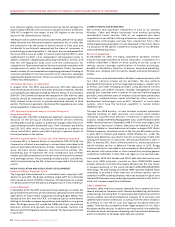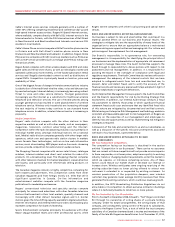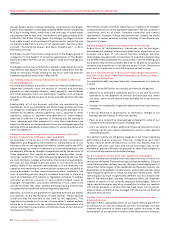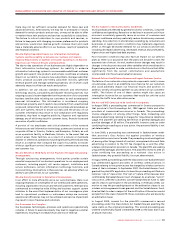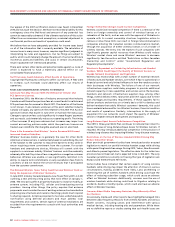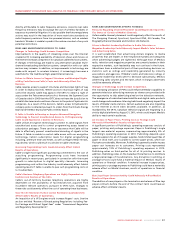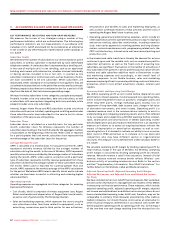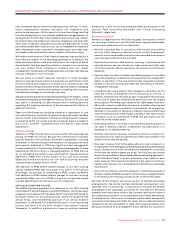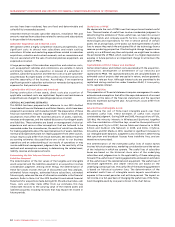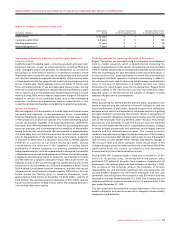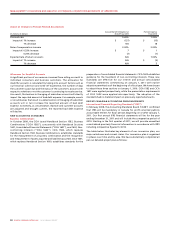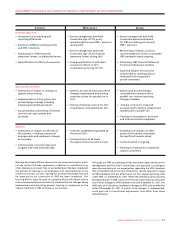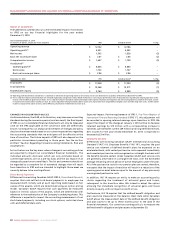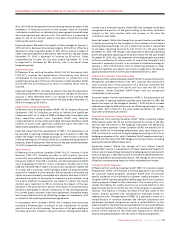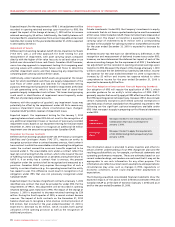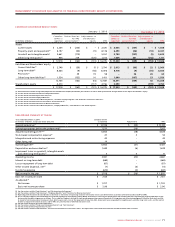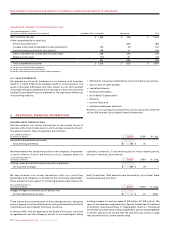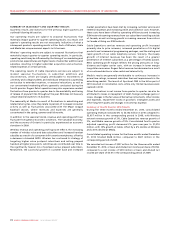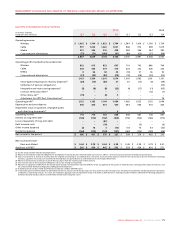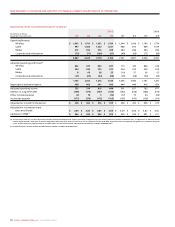Rogers 2010 Annual Report Download - page 62
Download and view the complete annual report
Please find page 62 of the 2010 Rogers annual report below. You can navigate through the pages in the report by either clicking on the pages listed below, or by using the keyword search tool below to find specific information within the annual report.
MANAGEMENT’S DISCUSSION AND ANALYSIS OF FINANCIAL CONDITION AND RESULTS OF OPERATIONS
66 ROGERS COMMUNICATIONS INC. 2010 ANNUAL REPORT
Impact of Changes in Pension-Related Assumptions
(In millions of dollars)
Accrued Benefit Obligation at
End of Fiscal 2010
Pension Expense
Fiscal 2010
Discount rate 5.60% 7.20%
Impactof:1%increase $ (137) $ (15)
1%decrease 165 18
Rate of compensation increase 3.00% 3.00%
Impactof:0.25%increase $ 7 $ 1
0.25%decrease (7) (1)
Expected rate of return on assets N/A 7.00%
Impactof:1%increase N/A $ (5)
1%decrease N/A 5
Allowance for Doubtful Accounts
A significant portion of our revenue is earned from selling on credit to
individual consumers and business customers. The allowance for
doubtful accounts is calculated by taking into account factors such as
our historical collection and write-off experience, the number of days
the customer is past due and the status of the customer’s account with
respect to whether or not the customer is continuing to receive service.
As a result, fluctuations in the aging of subscriber accounts will directly
impact the reported amount of bad debt expense. For example, events
or circumstances that result in a deterioration in the aging of subscriber
accounts will in turn increase the reported amount of bad debt
expense. Conversely, as circumstances improve and customer accounts
are adjusted and brought current, the reported bad debt expense
will decline.
NEW ACCOUNTING STANDARDS
Business Combinations
In October 2008, the CICA issued Handbook Section 1582, Business
Combinations (“CICA 1582”), concurrently with Handbook Sections
1601, Consolidated Financial Statements (“CICA 1601”), and 1602, Non-
controlling Interests (“CICA 1602”). CICA 1582, which replaces
Handbook Section 1581, Business Combinations, establishes standards
for the measurement of a business combination and the recognition
and measurement of assets acquired and liabilities assumed. CICA 1601,
which replaces Handbook Section 1600, establishes standards for the
preparation of consolidated financial statements. CICA 1602 establishes
guidance for the treatment of non-controlling interests. These new
standards are effective for our interim and annual consolidated
financial statements commencing on January 1, 2011 with earlier
adoption permitted as of the beginning of a fiscal year. We have chosen
to adopt these three sections on January 1, 2010. CICA 1582 and CICA
1601 were applied prospectively, while the presentation requirements
of CICA 1602 were applied retrospectively. The adoption of the
standards had no material impact on previously reported amounts.
RECENT CANADIAN ACCOUNTING PRONOUNCEMENTS
International Financial Reporting Standards (“IFRS”)
In February 2008, the Accounting Standards Board (“AcSB”) confirmed
that IFRS will be mandatory in Canada for profit-oriented publicly
accountable entities for fiscal periods beginning on or after January 1,
2011. Our first annual IFRS financial statements will be for the year
ending December 31, 2011 and will include the comparative period of
2010. Starting in the first quarter of 2011, we will provide unaudited
consolidated quarterly financial information in accordance with IFRS
including comparative figures for 2010.
The table below illustrates key elements of our conversion plan, our
major milestones and current status. Our conversion plan is organized
in phases over time and by area. We have substantially completed all
per our detailed project plan as follows:


